Canning chicken is something our great-grandparents knew all about. Preserving game and surplus meat for the leaner months or for your prepping reserves is a technique that’s well worth getting to grips with.
Water Bath or Pressure Canner?
First, it’s worth noting that many of our ancestors canned chicken without pressure canners, using a crockpot and a rolling boil. Chicken is a low acid food and we know that canning it in this way carries a risk of botulism. Why? Well, simply because it’s not possible to replicate the temperatures needed to destroy any spores using a regular water bath method.
On the other hand, our grandparents usually lived to tell the tale, but it’s ultimately your call. If you have a pressure cooker or canner, then follow the instructions to the end of Step 3; then check the manufacturer’s guidance for cooking up the jars and take a look at the processing times from the USDA on home canning meats at different altitudes to check what applies to you.
Related: How To Preserve Beef in Glass Jars
It’s also worth taking your time and making doubly sure that everything is scrupulously clean.
You’ll need:
- Fresh chicken
- Salt
- Jars with lids/seals suitable for preserving at high temperatures
#Step 1
Sterilize your jars by putting them through a hot cycle in the dishwasher, or cleaning by hand in very hot water with detergent and drying in the oven. Use the jars while still hot. If you’re using a pressure canner, then the jars and lids must be completely clean, but not necessarily sterilized.
#Step 2
Chop your chicken into approximately 1-inch pieces, discarding any fatty parts and using only the lean white meat for canning. The carcass can be boiled for stock and stripped of the remaining meat for later use. 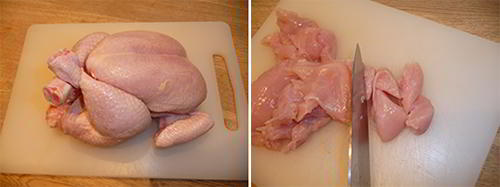
#Step 3
Pack the lean chicken pieces into ½ pint jars, pressing lightly and filling to within ¾ inch of the top of the jar, adding a very small amount of salt between layers.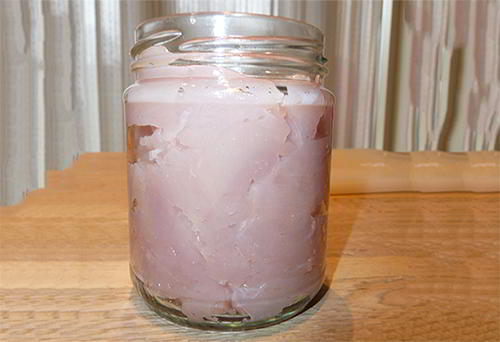
You don’t need to add any liquid; the chicken will produce its own broth during the canning process.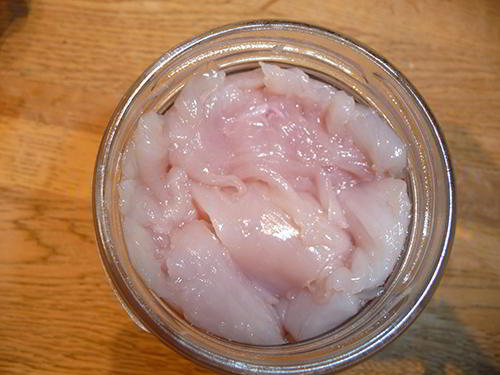
#Step 4
Place into a stockpot deep enough to completely submerge the jars and fill with water. Note that if using a pressure canner, the jars usually don’t need to be submerged. Bring to the boil, cover and keep on a rolling simmer for two – three hours (a pressure canner will take less time), topping up the water when necessary.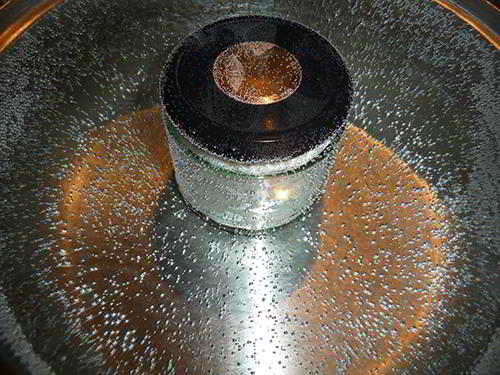
#Step 5
Remove the jars carefully and check that the seal is intact. The contents of any jars that don’t have an intact seal should be used immediately, refrigerated for up to three days or frozen.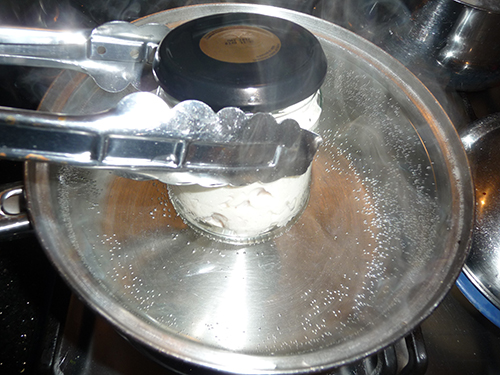
#Step 6
Chicken canned according to the water bath method should have a shelf life of 6 – 12 months when stored in a cool place, out of direct sunlight and preferably in a dark store. If you process the jars in a pressure canner, then you can look forward to a safe shelf life of up to two years or beyond when stored properly. Be sure to mark up your jars clearly with the date that the chicken was canned.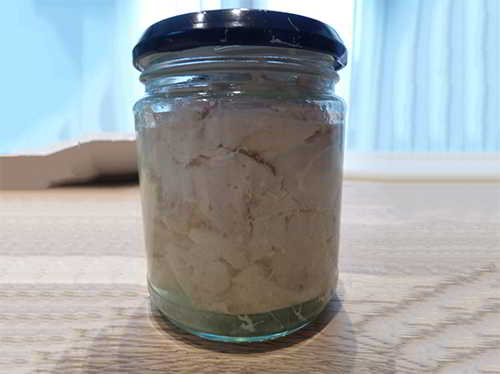
Canning Caution
Whether you use a crockpot or pressure canner, when it comes to eating your supplies, discard any jars with a bulging lid; signs of discoloration; a foul smell or that doesn’t have that vacuum-packed whoosh when it finally gets opened. Many people like to reheat the meat thoroughly before eating as a further precaution.
Canning meat in a water bath is still practiced by many, but there’s no getting away from the fact that it should come with a health caution: remember that botulism is odorless, tasteless and potentially deadly!
If you choose to bottle your chucks without a pressure canner, then make sure that the process you follow is as safe as possible. Ultimately, it’s your call, chicken lovers!
You may also like:
 DIY Chicken Tunnel (Step-by-Step Guide)
DIY Chicken Tunnel (Step-by-Step Guide)
How An EMP Will Affect Your State (Video)
All Churned Up – Making Your Own Delicious Butter
How to Build a Water Purification System in 10 Minutes
If you liked our article don’t forget to pin it!
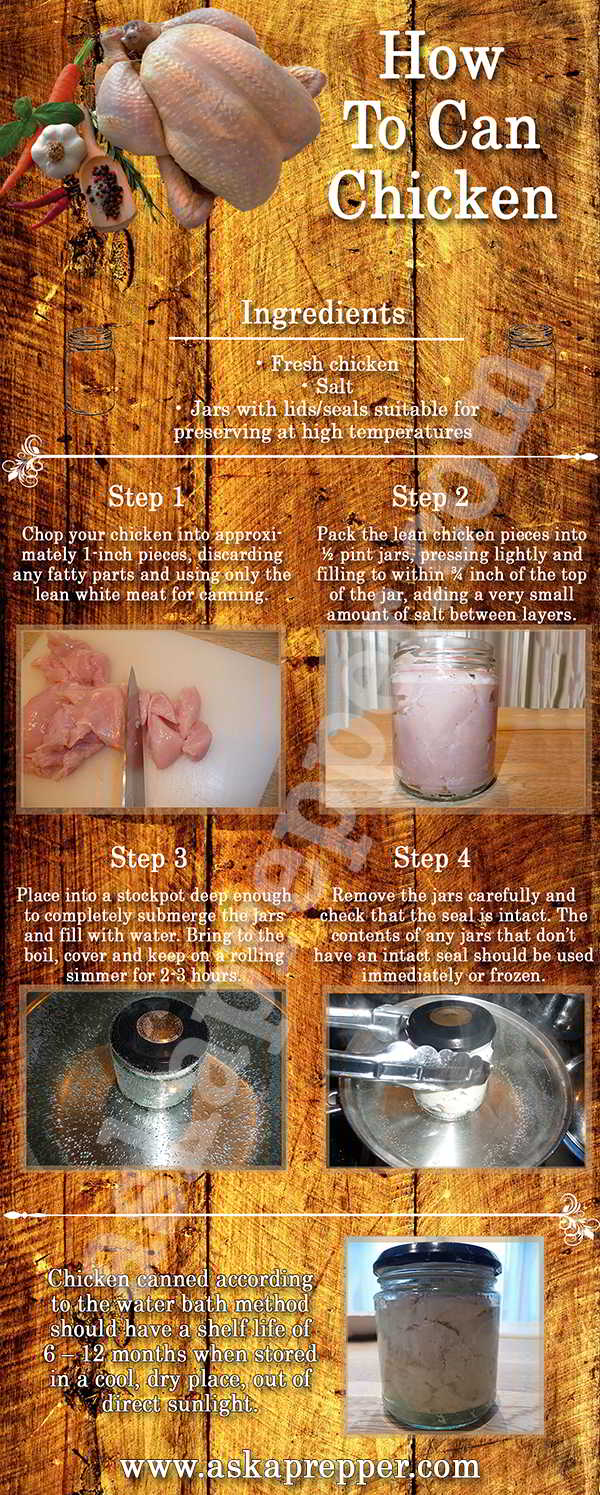

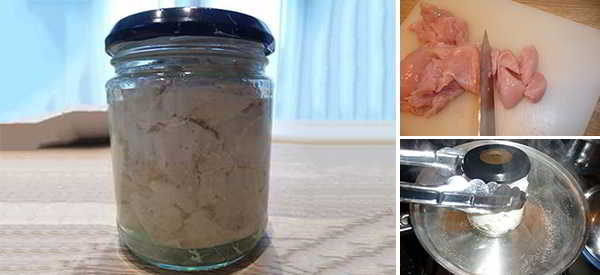













Sounds like good advice ,,We do lots of canning here in Arkansas. Keep up good work
Even a small electric canner is invaluable. I understand All American’s do not have rubber gaskets, a better investment for your “farm kitchen” or SHTF. I’ll be empying my freezer into canning jars soon. I think I heard one pd is a pint, two pds is a quart. There are several canner sites on facebook; I frequent Rebel Canner. Those people have a number of very valuable tips, not necessarily FDA approved, but well worth knowing.
Because of the botulism issue, I was under the impression that meat could Never be water-bath canned and Required pressure canning for safety. Does the amount of salt used change this pressure canning requirement?
The old ways only had water bath. Take advantage of the new ways to acquire a Pressure Canner. Why I mentioned an AA. I understand most stove top PC’s can be used on a wood stove or fireplace. We all need to be prepared.
Hi Kitty, no the salt won’t have any impact on the safety of the contents of the jar. It still remains that pressure canning is safest, even if you salt the chicken.
Hi Kitty, no I’m afraid the addition of salt doesn’t change things – it is still safer in a pressure canner.
you can water bath meat but it takes 3 hours of BOILING water to make it safe, my mom never had a PC until she was in her 70s and we all survived her canning meat she never owned a freezer until her kids were grown
I always add about a tablespoon of two of chopped onion, celery and carrot (a bit more onion than celery and carrot), to each jar of chicken. Not only does it give a fuller flavor, but the carrot gives a nice golden tint to the liquid.
I’m a total newbie to canning and I’ve water bathed some jams but I want to do some meat and vegetables and possibly potatoes. I just bought a pressure canner. Do you think it’s ok to add fresh herbs like rosemary, parsley, basil, and oregano to the chicken and other meat? Thank you ??
Cynthia, check out The Canning Diva’s website. Her post entitled “Spice Blend Recipes for Canning” has been very helpful! I would caution against using a lot of herbs as the canning process intensifies the flavors and can be overpowering if you use too much!
What kind of canning jars did you use? I’ve never seen a black lid like that. Thanks!
Hi Linda, apart from Mason-style ones, all of my canning jars are inherited or upcycled ones. Sorry I can’t help beyond that!
You should never use canning instructions from social media sites. Use only USDA or University websites for accurate information. Meat is only safe when canned in a pressure canner which is different than a pressure cooker. An open kettle water bath or pressure cooker is not safe for meat. Pressure canners are expensive but cook under more pressure raising the temperature of the foods inside to a point that kills botulism. You may have canned meat in many unsafe ways and never had a problem. Botulism spores are found in nature but are not always present.. Many times you will can something and not have any botulism in the jars then you’ll be fine, but if by chance there is botulism then you will almost definitely die. So err on the side of caution.
After SHTF, there won’t be an FDA. Better to learn now. Why this information exists. Am I a devote of Water bath meat?, not really, but the method exists.
Food and water borne illness is and always has been the leading cause of death world wide. In the US we forget that because it is so rare here. There are lots of things we can do to reduce these risks even in a SHTF situation. Skip the water bath and learn better methods of preservation of meat.
Buy a BALL BLUE BOOK canning guide can’t go wrong there
There is nothing worse than spoiled chicken (maybe fish) to get sick on. Please use pressure canning 90 minutes at 10 lbs altitude. (check your location).
I was reading the USDA guide from the link in the article. I have an electric pressure cooker and a presto pressure cooker. The article talks about dial gauge and weighted gauge cookers. Mine don’t have a dial, they have an automatic release..is that a weighted gauge?
Pressure cookers are great … for pressure cooking. An automatic release will not allow your pressure cooker to attain and maintain the proper pressure for canning. I use my Presto pressure canner to can 19 pints at a time, or 7 quarts, or 8 pint-and-a-halfs. Since I’m at 2600 ft. elevation, I need to maintain 12 lbs. pressure for the duration, which differs according to the food I’m canning. I can chicken thighs, skin removed but bone-in. You actually can the bone-in thighs less time than boneless! My 23 quart Presto pressure canner was about $80 several years ago, and I have since replaced the rubber gasket once, and added a second rack for stacking pints. Our Master Preserver (county extension trained) offers classes on many techniques. You need to be meticulous and methodical for safe and consistent results with pressure canning. The proper equipment is an investment, and though the All American brand is top of the line, a Presto will get you there safely at less than one third the price. Find a canning friend to start, and buy The Ball Complete Book of Home Preserving; used is still good. After I began to can, I wrote down what and how much I did for each recipe, so I could repeat the successes and avoid the failures (few). Good luck!
a weighted gauge is a metal piece you place on the canner top on a spindle and when pressure builds up it will rock. There is other info about it too but i have forgotten what it is. You can type in the search line on your computer ‘what is a weighted gauge for a pressure canner and get the info you need’.
The weighted gauge has a cylinder in the middle which pops up when the pressure starts building up. The first ring you will see is the 10 lb pound mark. The second 15 lb.
I am talking about the oldfashioned Presto
Cooker. A wonderfull thing if you dont forget to turn the gas down at 15 lb, otherwise the peasoup will be dripping from the ceiling.
CCTer, that is because they are NOT pressure CANNERS, they are pressure COOKERS, and can’ be used to pressure CAN foods.
The same with an Instant Pot, which is also a pressure COOKER. The pressure cookers only cook foods faster, but they are NOT safe to Pressure CAN foods. Please, ONLY use a stated PRESSURE CANNER to can foods. Any other appliance used will NOT get the food hot enough for long enough to kill all food borne bacteria, and can cause death.
IF YOU’RE BUYING A NEW PRESSURE CANNER…. BE SURE THAT IT WILL WORK ON A SMOOTH TOP STOVE – OR AN ELECTRIC STOVE. Some canners have a raised outer ring on the bottom – and don’t sit ‘flat’ on the cooking surface. My 23 qt Presto has a flat bottom in the center, and works fine on my smooth top. Also – BE SURE YOU GET PRESSURE WEIGHTS if your canner only comes with the gauge. They’re not expensive, and will keep you from baby-sitting the gauge to be sure it get to, and stays on, the right pressure.
Linda, where did you get the pressure weights for your presto?
Ebay sells jigglers/regulators/pressure weights
Some smooth top stove cannot take the heat of canning and will crack. It’s best to check your owner’s manual or with the manufacturer before attempting canning if you have a smooth top. When I was looking for a new stove that was the number one deal breaker for me.
Thank you Claude for sharing this with us. I have been canning for about 20 years. Never had a problem. I also have pemmican that is about 15 years old. I is as good as the day I made it. All of these people worried about botulism. I have made it several times at home for experiments. Let me tell you it is not easy to end up with the spores. Keep up the good work and when SHTF we are already prepared.
Dr. Jeffrey
Chemist.
Water bath canning of chicken is absurd. Pressure can it or pickle it. With pickling you can raise the pH high enough that there is not any possibility of botulism. Pickling meats has been practiced safely for centuries.
If things get bad enough after a long term SHTF event people may be canning PEOPLE !!!
When I can chicken, I use raw, whole boneless breasts. It only take two or three per quart jar since they’re usually big pieces. I cover in broth with about a half teaspoon of salt since the broth already contains some salt. Process at 15 pounds (I’m above 1,000 ft) for 90 minutes. The chicken falls apart went removed from the jar but is tender and great in casseroles, soups and other dishes.
Would adding some colloidal silver and lemon juice make the water-bath canned chicken safe from botulism? The silver would kill the botulism organisms; the lemon juice would add acidity and tenderize the chicken. If so, how much would be needed?
Thank you this is great information for all canners pleas stay safe.
So my freezer stopped working and I have thawed chicken and ground beef. Can’t afford a pressure canner, have a pressure cooker that is apparently useless, so choices appear to be death or throw out food we can’t use quickly enough. I wish my mother was alive, she raised 8 kids on home canned food, none of us died and she never had a pressure canner either.
Cook and dehydrate what you can use that way. Pickling and fermenting are also good options
Okay it is time for a reality check. Yes water bath canning can allow botulism spores to remain and produce the deadly toxin. However, the toxin is denatured and destroyed by boiling at 212F for 10 minutes as per the USDA, the WHO states 185C for 5 minutes! So meats that have been canned should be boiled for 10 minutes and they are then perfectly safe for consumption. If you don’t believe me then Google it.
I think the trouble comes from consumption of low acid foods water bath canned and then consumed uncooked. This is luck of the draw at best.
Correction= WHO says 185F for 5 minutes.
The amish communitiy I work in only does water baths including chichen. I know it’s not approved so you decide for yourself.
im fairly new to canning but I have been pressure canning some meats. last night for the first time I found chicken juice in the canner when I opened it up after the cycle was finished. all the jars sealed and so far look good but is there any concern about this being a problem since there is juice between the jar and the sealing surface of the lid? cant find any real info anywhere. a friend said its good as long as they stay sealed?
I have chicken I want to water bath. Literally, cold chicken in cold jars, nothing else, keep a boiling roll for 3 hours… is this wrong?